Story by By Allison Morrow, CNN •10h
Burning Man, the desert confab that descended into chaos over the weekend, isn’t quite the scrappy, free-spirited revelry that it once was.
For many watching the disarray of Burning Man from afar, the rain and mud that left 70,000 people stranded quickly became a symbol of the festival’s departure from its roots.
Or, more simply: how the billionaires ruined Burning Man.
The festival began as a small gathering in 1986 on a San Francisco beach, and eventually grew into a gritty countercultural community of “Burners” who eschew commercialism within their makeshift city, erected annually in a desiccated lake bed known as the playa.
There’s no money trading hands on the playa — that’s core to to the community’s “decommodification” ethos. But there is, increasingly, a lot of money on the playa.
Going to Burning Man is, in some elite circles, akin to having climbed Everest or taken ayuhuasca on a meditation retreat — a spiritually transformative experience, undertaken with a considerable safety net of privilege.
Elon Musk, the world’s wealthiest person, has been a regular at Burning Man, telling Recode in 2014 that “if you haven’t been, you just don’t get it.” Mark Zuckerberg flew in for a day in 2012 to serve up grilled cheese sandwiches and even set up his own tent, according to his friend and Facebook co-founder Dustin Moskovitz. In 2018, shortly after she was indicted on federal fraud charges, Theranos founder Elizabeth Holmes retreated to the desert and burned an effigy for her failed startup, she told the New York Times.
One of the 10 pillars of Burning Man is “radical self-reliance,” and in that spirit most revelers haul their own water and shelf-stable food in for the week, and “rely on their inner resources” for survival, according to the organization’s website.
For the one-percenters in attendance, however, self-reliance can be outsourced.
The ultra-wealthy have been known to fly in personal chefs for the week, and pay as much as $50,000 to camp in luxurious tents, as the New York Post reported in 2019. A Business Insider reporter, similarly, wrote about so-called fancy camps around the playa that came with chandeliers, party rooms and outdoor showers.
“Burning Man is the perfect example of how many rich White people recreationally manufacture hardship because they are immune from it systematically,” wrote one user on X, formerly Twitter, this weekend.
The infiltration of the jet set is the driving force behind the schadenfreude emanating from social media in response to video footage of Burners — some of whom paid $2,750 for a single ticket — tromping through ankle-deep mud, unable to drive out of the camp following unusually heavy rain.
“It’s a tiny violin emoji for me,” wrote one TikTok user.
While some festival-goers found the situation scary — a “Lord of the Flies” vibe, as one attendee described it — many seasoned Burners were taking the weather and road closures in stride, offering food and shelter to those who need it. While one person died at the festival, the death was “unrelated to the weather.”
One attendee, Andrew Hyde, told CNN the rain and mud have taken the meaning of the event back to its roots.
“You come out here to be in a harsh climate, and you prepare for that.”
— Nouran Salahieh and Holly Yan contributed to this article.
Burning Man costs most people a minimum of $800 for just a ticket and a parking spot. All the other expenses can easily push the total cost into the thousands.
Story by sjackson@insider.com (Sarah Jackson) •8h
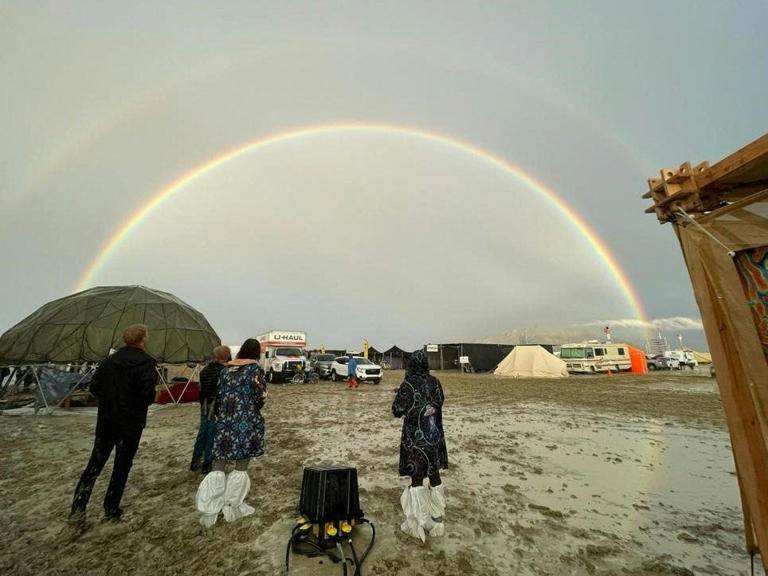
Nevada's nine-day Burning Man festival can cost Burners hundreds, and sometimes thousands, of dollars to attend. JULIE JAMMOT/Getty Images© Provided by Business Insider
Burning Man may be "decommodified" but it's still pretty expensive to attend.
The 9-day festival cost most Burners at least $800 this year, just for a ticket and a vehicle pass.
Transportation, food, and other survival-related supplies can easily push the cost into the thousands.
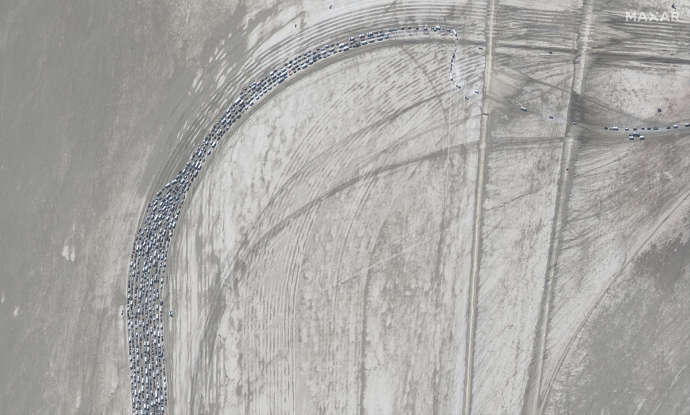
1 of 9 Photos in Gallery©Maxar Technologies/Handout via REUTERS
See the mass exodus of vehicles inching through the Nevada desert as people clamor to escape Burning Man's soggy Black Rock City playa
Burning Man 2023's Exodus — when all its attendees depart — officially began on Monday.
Festivalgoers had been trapped as desert roads became waterlogged from torrential rains.
Photos show hundreds of vehicles making their escape from muddy festival as it draws to a close.
Festivalgoers could finally depart Burning Man on Monday after being trapped for days by heavy rains that swamped event's makeshift desert town in thick mud.
The nine-day party event turned into a soggy disaster when a downpour turned the desert into a massive mud pit. Attendees were told to hunker down and ration food and water, and organizers rebooted their guidelines page, called a "survival guide," into a "Wet Playa Survival Guide."
A driving ban was lifted at 2 p.m. Pacific Time on Monday as roads out of the festival site began to dry, allowing a remaining 64,000 attendees to leave.
Hundreds of trucks, buses, and other vehicles poured out of Black Rock City on Monday, with attendees being asked to consider postponing their exit to avoid a traffic build-up.
Here's a look at the exodus from Burning Man 2023 as the beleaguered event draws to a close.See More
Burning Man only sells ice on site, but don't let that fool you: Burners still shell out a small fortune to be there.
The typically nine-day event in Nevada's Black Rock Desert, roughly 120 miles north of Reno, draws tens of thousands of attendees each year, and sets them all back at least $630 for a ticket including its taxes and fee — with total costs easily ballooning into the thousands.
The survival supplies aren't anything to scoff at either. This year, a storm put a damper on the festivities, turning much of the famous playa into mud and resulting in stranded attendees.
Here's a closer look at the expenses you're on the hook for as a Burner.
Tickets alone aren't cheap
Most tickets sold directly from Burning Man cost $575 each this year, according to the event's website. (There are 5,000 tickets available at a discounted $225 for people with financial hardships, and "FOMO" tickets priced at $1,500 and $2,750 for Burners who want to secure their spots two months before the main sale opens.) Vehicle passes, which are required for every vehicle driving into Black Rock City, cost $150 each; for Burners who qualified for discounted rates due to financial hardships, vehicle passes are $75 each.
All tickets are subject to the 9% Nevada Live Entertainment Tax; on the $575 tickets, this tax comes out $51.75 each. Both tickets and vehicle passes are subject to a $4 fee each. There's also a 3.4% credit card processing fee on purchase subtotals.
All told, this means Burners are shelling out at least $800 between tickets, vehicle passes, fees, and taxes if they're attending solo. Lots of people carpool, however, which means you can share the cost of the vehicle pass, but the ticket and its taxes and fees alone will set you back around $630.
Transportation and lodging can easily cost thousands
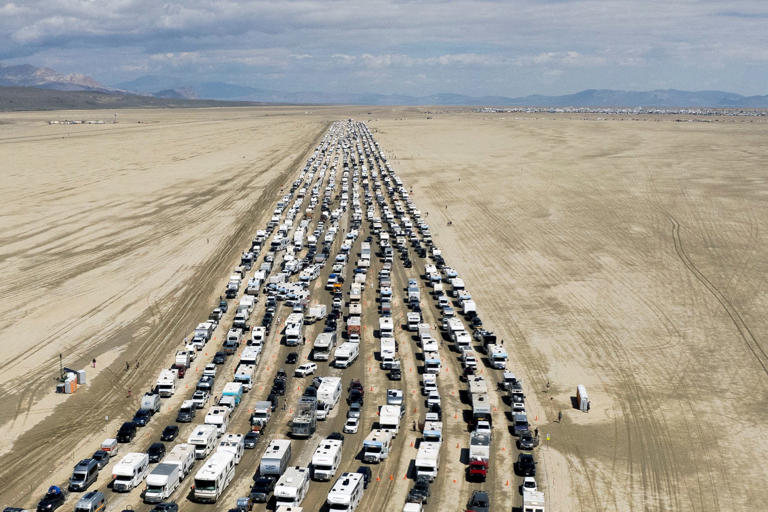
Lots of Burning Man attendees opt for an RV — which can be costly to rent. Matt Mills McKnight/REUTERS© Matt Mills McKnight/REUTERS
Don't forget you have to actually get to the playa. And you also have to figure out where you're going to sleep for 9 days.
Burners coming from other parts of the country will likely have to cover airfare or the cost of other transportation to Reno, and then take additional transportation from the Reno airport to Black Rock City. Some attendees of the festival, which is popular with influencers and the wealthy tech elite, even fly in on private jets, which were the subject of protests at this year's Burning Man.
Once you've arrived, there's also the matter of food, water, and lodging. One Burning Man veteran recommends budgeting $10 a day for food, water, and supplies when cooked in a communal kitchen for a group, which would come out to another $90. In keeping with the festival's emphasis on "radical self-reliance," Burners should also be budgeting for supplies like shade structures, sleeping gear, and toiletries. A list of recommended survival supplies on Burning Man's website could easily add up to $100 or more.

A screenshot from Burning Man's website of items "you should probably bring." Burning Man© Burning Man
As for lodging, many people pitch tents, rent RVs, or even stay in yurts.
RV rentals can easily set you back thousands of dollars: Multiple RV rental websites estimate even a basic rental will cost anywhere between $5,500 and $7,000, and if you're staying with other attendees, the biggest RVs start at around $10,000.
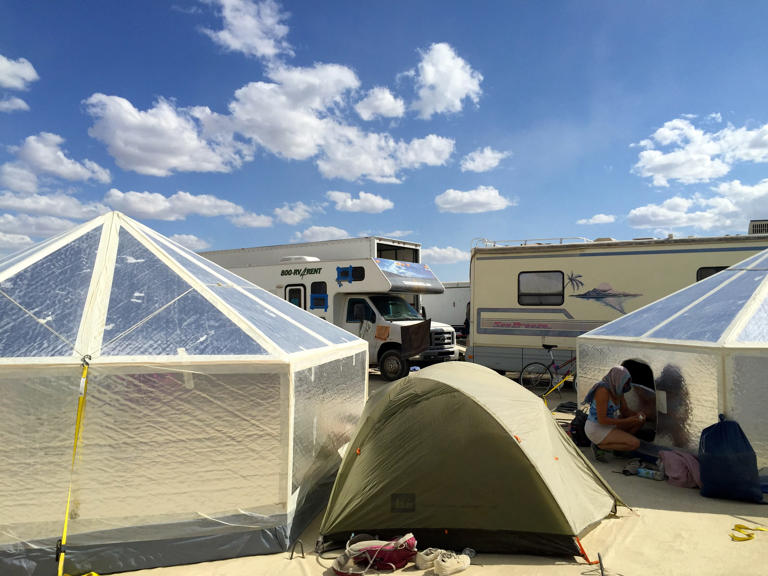
Yurts at a past Burning Man. Aly Weisman/Business Insider© Aly Weisman/Business InsiderOne website advertising yurts for Burning Man lists structures ranging in price from $3,000 to $11,500. Many attendees often camp together, sometimes paying a hefty price to do so: One luxury camp infamously charged up to $100,000 for accommodations, private chef included, before Burning Man shut it down.
Smaller, optional expenses can add up
Black Rock City, the temporary city constructed once a year, is enormous and can take a while to traverse by foot — so many people opt to bring or rent a bicycle to get around, as driving is prohibited on the playa except when arriving or departing the festival. Burning Man's approved bike shops offer rentals from $80 to $125 and up for the duration of the festival.
Then, there's also the freewheeling fashion of Burning Man. Another one of the festival's central tenets is self-expression, and attendees are known to sport flamboyant outfits and costumes, with people dressing up in steampunk or sci-fi outfits. It's entirely optional and you can always cobble together something unique from what you already own, but if you're starting from scratch or want a more elaborate costume, it's yet another expense to consider.
CNNHuge exodus of people getting out of the Burning Man festival in Nevada.Duration 0:37 View on WatchRelated video: Man stuck at Burning Man tells Channel 13 about festival conditions (KTNV Las Vegas, NV)Duration 2:25 View on WatchThe Wall Street Journal Burning Man Revelers Describe ‘Disaster Like Never Been Seen’1:31NBC News Burning Man attendees makes the best of muddy festival: ‘The best burn ever!’1:08Daily Mail Enormous lines of Burning Man attendees make painfully slow departure
Burners coming from other parts of the country will likely have to cover airfare or the cost of other transportation to Reno, and then take additional transportation from the Reno airport to Black Rock City. Some attendees of the festival, which is popular with influencers and the wealthy tech elite, even fly in on private jets, which were the subject of protests at this year's Burning Man.
Once you've arrived, there's also the matter of food, water, and lodging. One Burning Man veteran recommends budgeting $10 a day for food, water, and supplies when cooked in a communal kitchen for a group, which would come out to another $90. In keeping with the festival's emphasis on "radical self-reliance," Burners should also be budgeting for supplies like shade structures, sleeping gear, and toiletries. A list of recommended survival supplies on Burning Man's website could easily add up to $100 or more.

A screenshot from Burning Man's website of items "you should probably bring." Burning Man© Burning Man
As for lodging, many people pitch tents, rent RVs, or even stay in yurts.
RV rentals can easily set you back thousands of dollars: Multiple RV rental websites estimate even a basic rental will cost anywhere between $5,500 and $7,000, and if you're staying with other attendees, the biggest RVs start at around $10,000.

Yurts at a past Burning Man. Aly Weisman/Business Insider© Aly Weisman/Business InsiderOne website advertising yurts for Burning Man lists structures ranging in price from $3,000 to $11,500. Many attendees often camp together, sometimes paying a hefty price to do so: One luxury camp infamously charged up to $100,000 for accommodations, private chef included, before Burning Man shut it down.
Smaller, optional expenses can add up
Black Rock City, the temporary city constructed once a year, is enormous and can take a while to traverse by foot — so many people opt to bring or rent a bicycle to get around, as driving is prohibited on the playa except when arriving or departing the festival. Burning Man's approved bike shops offer rentals from $80 to $125 and up for the duration of the festival.
Then, there's also the freewheeling fashion of Burning Man. Another one of the festival's central tenets is self-expression, and attendees are known to sport flamboyant outfits and costumes, with people dressing up in steampunk or sci-fi outfits. It's entirely optional and you can always cobble together something unique from what you already own, but if you're starting from scratch or want a more elaborate costume, it's yet another expense to consider.
The Burning Man disaster is ‘a teachable moment’ about climate change
Story by Dino Grandoni, Kim Bellware •
 The Washington Post
The Washington Post
Burning Man Topper
Burning Man is supposed to arrive and disappear like the desert breeze.
Near the end of every summer, attendees of the multiday mega-festival venture to the Nevada wilderness. Their motto: “Leave no trace.”
This year, thousands got stuck in the mud instead after about a half an inch of rain hit what is normally the driest state in the nation. Instead of leaving no trace, many self-described “burners” abandoned bicycles and vehicles on the drenched, muddy Black Rock Desert.
Once an underground carnival for free spirits, Burning Man today is famous as a party spot for Hollywood stars, Silicon Valley tech bros and other jet-set elites. The latest event offers a glimpse at how extreme weather can — and more frequently will — dramatically transform the environment in a moment’s notice.
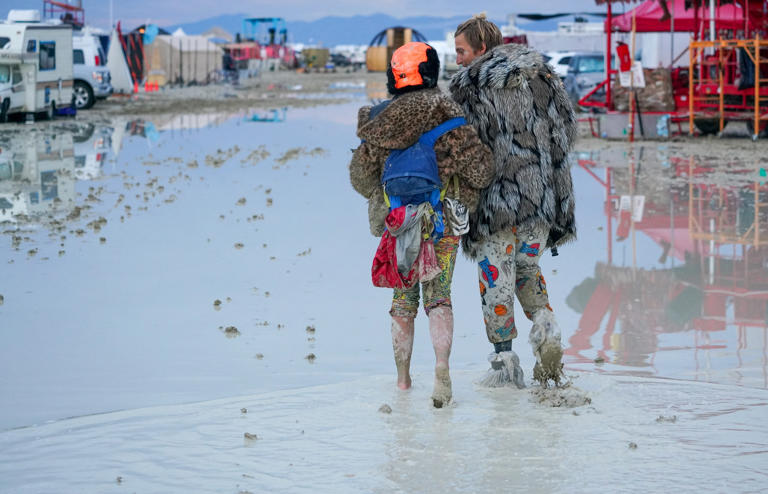
The Burning Man disaster is ‘a teachable moment’ about climate change
“It’s a teachable moment, as far as climate disasters and extreme weather” go, said Anya Kamenetz, a Burning Man attendee forced to flee the festival. “This is very much just a trial run under really, really easy conditions for what a lot of people go through.”
No single storm can be attributed to climate change. But flooding in Nevada is expected to become more frequent as storms intensify and snow shifts to rain due to higher temperatures, according to state officials.
On Aug. 27, as the festival was getting started, climate activists blockaded a road into Burning Man in protest of its environmental footprint.
This year’s event is only expected to fuel critics who have long charged the festival for leaving trash in surrounding communities and not living up to its eco-conscious goals as crowds rush away from the encampment. As festivalgoers made the long trek to the exits, they left more behind than usual, including cars, Pershing County Sheriff Jerry Allen said.
“This behavior definitely does not fall within the 10 principles of Burning Man,” he said. The neglect, he added, is “a societal issue” and not necessarily the fault of the Burning Man Project, the group behind the festival.
Burning Man gets rained out
At first, a sprinkling of rain helped settle some of the dust swirling through the encampment. But by Friday evening, the rain didn’t stop — and it didn’t take much precipitation to turn the playa into a muddy mess.
“By the time we went to bed that night, it was really clear that this is going to be something that would shut down the city,” said Kamenetz, who writes a Substack newsletter about climate change.
By Saturday morning, the burners were trapped. Those who remained held a camp meeting, Kamenetz said. No more showers, no more dishwashing. No more portable toilet use except for solid waste.
Unsure of when attendees would be able to leave, organizers urged those who remained to conserve food, water and fuel. The gates and airport in and out of what was supposed to be a desert oasis were closed.
So, burners sheltered in place. Festivalgoers covered their tents in tarps to keep the rain out. The mud was so thick and sticky that many abandoned their hiking boots, trekking through the encampment barefoot or slipping plastic bags over their socks.
To dig mud out of a portable toilet, Kamenetz unbolted a gold-colored decorative shovel attached to a zebra-striped, safari-themed vehicle brought to Burning Man as an “art car.”
“It was gold,” she said of the shovel. “It’s not gold anymore.”
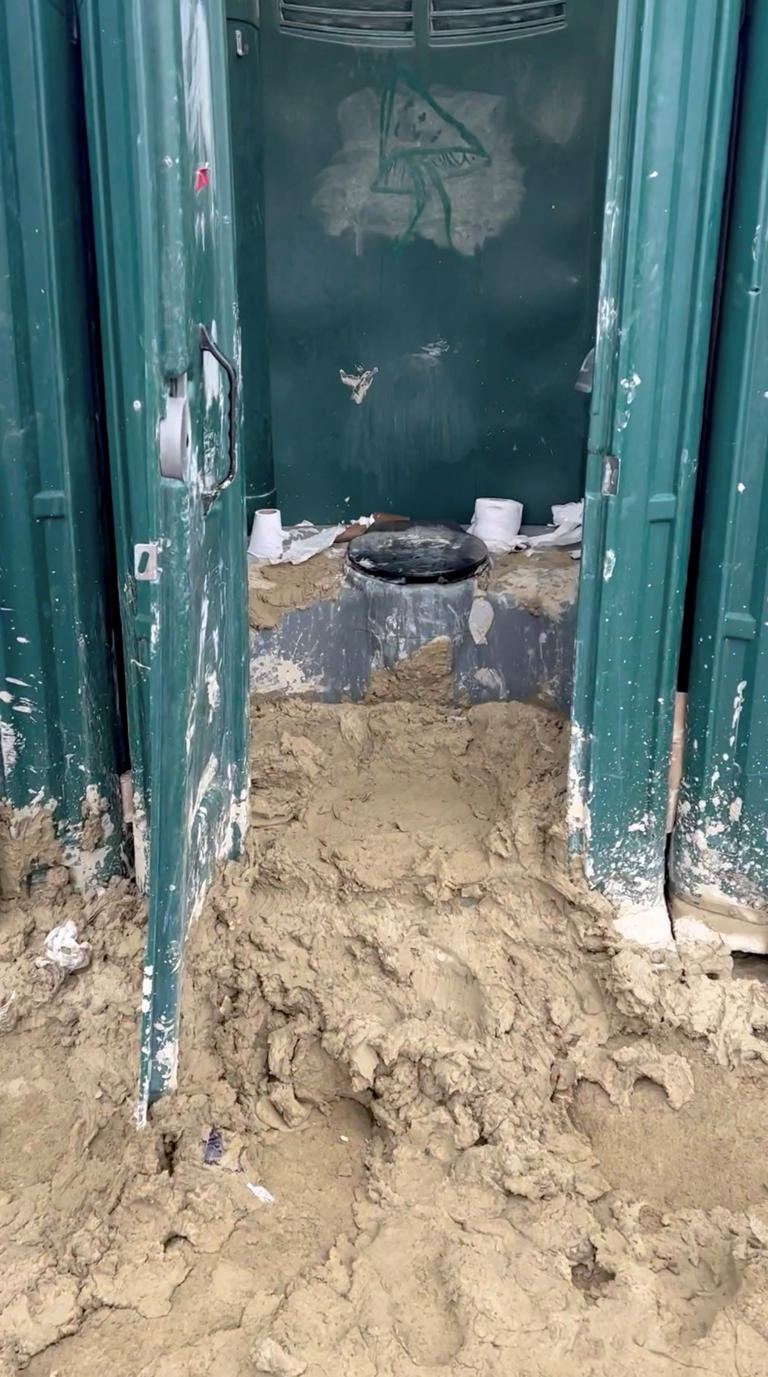
Sept. 3 | Black Rock City, Nev. A portable toilet covered in mud.
‘Better prepared than the average Joe Schmo’
This year’s Burning Man brought some of the most extreme weather Christine Lee had seen in the eight years she’s attended the festival.
But many burners, particularly veterans of the festival, are resourceful and well-prepared for the week-plus of off-the-grid survival, said the 39-year-old circus performer. Lee traveled with friends in a built-out conversion van, so they were equipped with heat, air conditioning and power — as well as stacks upon stacks of foil-wrapped packs of tuna.
“I did have enough tuna for an extra week,” Lee said. While there were moments of panic over the sight of overflowing toilets and calls to reserve food and water, people coming to Burning Man follow the principles of self-reliance and community, she said.
“They’re going to be prepared better than the average Joe Schmo,” Lee added.
 The Washington Post
The Washington Post
Rain falls during Burning Man
Burning Man effigy ignites
Duration 0:20
View on Watch

A Burning Man attendee and their costume in front of dozens of bikes on the playa. Aly Weisman/Business Insider© Aly Weisman/Business Insider
It's not mandatory, but since gift-giving is one of Burning Man's 10 core principles, it's common for attendees to also factor into their budgeting equations gifts to bring and share with one another.
Add it all up, and Burning Man can easily set you back at least $1,000 to $2,000 unless you've gotten really creative and figured out a way to pinch pennies and carpool — and even then you're looking at the high hundreds of dollars.
Let's just hope next year's Burners get more for their money than a giant mud pit.
Story by Dino Grandoni, Kim Bellware •
 The Washington Post
The Washington PostBurning Man Topper
Burning Man is supposed to arrive and disappear like the desert breeze.
Near the end of every summer, attendees of the multiday mega-festival venture to the Nevada wilderness. Their motto: “Leave no trace.”
This year, thousands got stuck in the mud instead after about a half an inch of rain hit what is normally the driest state in the nation. Instead of leaving no trace, many self-described “burners” abandoned bicycles and vehicles on the drenched, muddy Black Rock Desert.
Once an underground carnival for free spirits, Burning Man today is famous as a party spot for Hollywood stars, Silicon Valley tech bros and other jet-set elites. The latest event offers a glimpse at how extreme weather can — and more frequently will — dramatically transform the environment in a moment’s notice.

The Burning Man disaster is ‘a teachable moment’ about climate change
“It’s a teachable moment, as far as climate disasters and extreme weather” go, said Anya Kamenetz, a Burning Man attendee forced to flee the festival. “This is very much just a trial run under really, really easy conditions for what a lot of people go through.”
No single storm can be attributed to climate change. But flooding in Nevada is expected to become more frequent as storms intensify and snow shifts to rain due to higher temperatures, according to state officials.
On Aug. 27, as the festival was getting started, climate activists blockaded a road into Burning Man in protest of its environmental footprint.
This year’s event is only expected to fuel critics who have long charged the festival for leaving trash in surrounding communities and not living up to its eco-conscious goals as crowds rush away from the encampment. As festivalgoers made the long trek to the exits, they left more behind than usual, including cars, Pershing County Sheriff Jerry Allen said.
“This behavior definitely does not fall within the 10 principles of Burning Man,” he said. The neglect, he added, is “a societal issue” and not necessarily the fault of the Burning Man Project, the group behind the festival.
Burning Man gets rained out
At first, a sprinkling of rain helped settle some of the dust swirling through the encampment. But by Friday evening, the rain didn’t stop — and it didn’t take much precipitation to turn the playa into a muddy mess.
“By the time we went to bed that night, it was really clear that this is going to be something that would shut down the city,” said Kamenetz, who writes a Substack newsletter about climate change.
By Saturday morning, the burners were trapped. Those who remained held a camp meeting, Kamenetz said. No more showers, no more dishwashing. No more portable toilet use except for solid waste.
Unsure of when attendees would be able to leave, organizers urged those who remained to conserve food, water and fuel. The gates and airport in and out of what was supposed to be a desert oasis were closed.
So, burners sheltered in place. Festivalgoers covered their tents in tarps to keep the rain out. The mud was so thick and sticky that many abandoned their hiking boots, trekking through the encampment barefoot or slipping plastic bags over their socks.
To dig mud out of a portable toilet, Kamenetz unbolted a gold-colored decorative shovel attached to a zebra-striped, safari-themed vehicle brought to Burning Man as an “art car.”
“It was gold,” she said of the shovel. “It’s not gold anymore.”

Sept. 3 | Black Rock City, Nev. A portable toilet covered in mud.
© Instagram @martinposc/Reuters
Revelers tried to make the best out of a bad situation. During the day, the group sculpted a statue of an elephant out of mud. At night, they played music. As a sign, perhaps, that things would be okay, a rainbow arched across the playa Saturday.
“People really didn’t miss a beat,” Kamenetz said.
Revelers tried to make the best out of a bad situation. During the day, the group sculpted a statue of an elephant out of mud. At night, they played music. As a sign, perhaps, that things would be okay, a rainbow arched across the playa Saturday.
“People really didn’t miss a beat,” Kamenetz said.
‘Better prepared than the average Joe Schmo’
This year’s Burning Man brought some of the most extreme weather Christine Lee had seen in the eight years she’s attended the festival.
But many burners, particularly veterans of the festival, are resourceful and well-prepared for the week-plus of off-the-grid survival, said the 39-year-old circus performer. Lee traveled with friends in a built-out conversion van, so they were equipped with heat, air conditioning and power — as well as stacks upon stacks of foil-wrapped packs of tuna.
“I did have enough tuna for an extra week,” Lee said. While there were moments of panic over the sight of overflowing toilets and calls to reserve food and water, people coming to Burning Man follow the principles of self-reliance and community, she said.
“They’re going to be prepared better than the average Joe Schmo,” Lee added.
The social contract Burning Man is known for largely held up, though Lee noticed human waste outside one trailer, and more forks and litter — sights she hadn’t seen in past year. Lee chalked it up to a small percent of attendees behaving selfishly.
The broader community stepped up to clean the grounds and shelter, and to feed burners who were struggling as resources dwindled, she said. Burning Man is famously “commerce-free” — or at least strives to be — which means everything including meals and bicycle repair is barter and community-based.
“It totally worked — there’s nowhere else I’d rather be in the middle of a zombie apocalypse,” Lee said. “I’d see people walking around with trash bags, offering water, handing out food. You see someone clearly struggling because they look hungry and doesn’t have a poncho and you help them.”
The broader community stepped up to clean the grounds and shelter, and to feed burners who were struggling as resources dwindled, she said. Burning Man is famously “commerce-free” — or at least strives to be — which means everything including meals and bicycle repair is barter and community-based.
“It totally worked — there’s nowhere else I’d rather be in the middle of a zombie apocalypse,” Lee said. “I’d see people walking around with trash bags, offering water, handing out food. You see someone clearly struggling because they look hungry and doesn’t have a poncho and you help them.”
The rain arrived as Reno, the largest nearby city, is in the middle of its second-wettest year on record, according to Scott McGuire, a meteorologist with the National Weather Service.
The area has entered a “boom-or-bust” mode when it comes to rain, oscillating between wet and drought years. “We swing on this pendulum,” McGuire said.
Rainstorms like the one over Labor Day weekend are unusual but not unprecedented for the region, he added.
The Southwest United States has seen more rain than normal this year, both because of an active monsoon as well as the passage of Tropical Storm Hilary. Around the same time downpours drenched Burning Man, torrential rain also brought flooding to Las Vegas, which has received 2.55 inches of rain during the monsoon season, the 11th-most on record.
On Friday, the Weather Service’s forecast had predicted isolated thunderstorms and scattered showers for the area over the weekend.
A muddy exodus
Burning Man Project chief executive Marian Goodell told NBC News that the group was “prepared for the whole spectrum” of weather scenarios.
“We’ve chosen a dry lake bed” for the event, she said. “The environment is always a survival environment.”
Yet by Sunday, an exodus was underway even as roads remained closed. Over Labor Day, people pushed RVs and kicked mud out from under wheels to get them to move. Others hoofed it by foot. Kamenetz walked more than three miles through mud to catch a bus.
The area has entered a “boom-or-bust” mode when it comes to rain, oscillating between wet and drought years. “We swing on this pendulum,” McGuire said.
Rainstorms like the one over Labor Day weekend are unusual but not unprecedented for the region, he added.
The Southwest United States has seen more rain than normal this year, both because of an active monsoon as well as the passage of Tropical Storm Hilary. Around the same time downpours drenched Burning Man, torrential rain also brought flooding to Las Vegas, which has received 2.55 inches of rain during the monsoon season, the 11th-most on record.
On Friday, the Weather Service’s forecast had predicted isolated thunderstorms and scattered showers for the area over the weekend.
A muddy exodus
Burning Man Project chief executive Marian Goodell told NBC News that the group was “prepared for the whole spectrum” of weather scenarios.
“We’ve chosen a dry lake bed” for the event, she said. “The environment is always a survival environment.”
Yet by Sunday, an exodus was underway even as roads remained closed. Over Labor Day, people pushed RVs and kicked mud out from under wheels to get them to move. Others hoofed it by foot. Kamenetz walked more than three miles through mud to catch a bus.
Every year, large piles of trash are left in Reno and other spots outside the desert, said Allen, the Pershing County sheriff.
“This year is a little different in that there are numerous vehicles strewn all throughout the playa for several miles,” he added. “Some participants were unwilling to wait or use the beaten path to attempt to leave the desert and have had to abandon their vehicles and personal property wherever their vehicle came to rest.”
The Burning Man Project, Allen added, is responsible for cleaning up the trash in the desert. The project did not immediately respond to a request for comment from The Washington Post.
By Tuesday morning, the departure was “going smoothly” despite the heavy volume of travelers, Pershing County Sheriff Sgt. Nathan Carmichael said. The only major incident from Burning Man that the sheriff’s office was actively investigating Monday was the death of Leon Reece, a 32-year-old attendee who was found unresponsive at the festival Friday.
At the Reno-Tahoe International Airport, operations were returning to “business as usual” after a double dose of traffic from Labor Day travelers and the influx of burners headed home, according to spokesperson Stacey Sunday.
The airport on Monday tallied around 7,000 passengers, Sunday said, citing TSA data — compared with 4,000 to 6,000 travelers on a typical day.
Among the ways airport officials typically prepare for Burning Man travelers is to have plastic bags on hand to wrap their dust-covered luggage so that baggage machines don’t get clogged. This year, the airport provided travelers with disposable booties to cover their mud-caked shoes.
“[It’s] our biggest thing because there’s construction going outside, there isn’t the curb for burners to sit on, make flight arrangements,” Sunday said. “They’re either inside or out, but it doesn’t seem to be a big deal.”
This year’s experience hasn’t deterred Lee from Burning Man, though she plans to pack more boots and ponchos in case of rough weather next year. Even the hard rain, she said, created a joyful, art-filled memory. During a brief period when the rain slowed this past weekend, people started walking the streets and creating mud art: clay Minions and Buddhas and snowmen.
But Kamenetz, a nine-time attendee, said this would be her last Burning Man, a decision she had considered even before the rain.
“Is this really how I want to be spending my leisure time?”
Jason Samenow contributed to this report.
“This year is a little different in that there are numerous vehicles strewn all throughout the playa for several miles,” he added. “Some participants were unwilling to wait or use the beaten path to attempt to leave the desert and have had to abandon their vehicles and personal property wherever their vehicle came to rest.”
The Burning Man Project, Allen added, is responsible for cleaning up the trash in the desert. The project did not immediately respond to a request for comment from The Washington Post.
By Tuesday morning, the departure was “going smoothly” despite the heavy volume of travelers, Pershing County Sheriff Sgt. Nathan Carmichael said. The only major incident from Burning Man that the sheriff’s office was actively investigating Monday was the death of Leon Reece, a 32-year-old attendee who was found unresponsive at the festival Friday.
At the Reno-Tahoe International Airport, operations were returning to “business as usual” after a double dose of traffic from Labor Day travelers and the influx of burners headed home, according to spokesperson Stacey Sunday.
The airport on Monday tallied around 7,000 passengers, Sunday said, citing TSA data — compared with 4,000 to 6,000 travelers on a typical day.
Among the ways airport officials typically prepare for Burning Man travelers is to have plastic bags on hand to wrap their dust-covered luggage so that baggage machines don’t get clogged. This year, the airport provided travelers with disposable booties to cover their mud-caked shoes.
“[It’s] our biggest thing because there’s construction going outside, there isn’t the curb for burners to sit on, make flight arrangements,” Sunday said. “They’re either inside or out, but it doesn’t seem to be a big deal.”
This year’s experience hasn’t deterred Lee from Burning Man, though she plans to pack more boots and ponchos in case of rough weather next year. Even the hard rain, she said, created a joyful, art-filled memory. During a brief period when the rain slowed this past weekend, people started walking the streets and creating mud art: clay Minions and Buddhas and snowmen.
But Kamenetz, a nine-time attendee, said this would be her last Burning Man, a decision she had considered even before the rain.
“Is this really how I want to be spending my leisure time?”
Jason Samenow contributed to this report.
 The Washington Post
The Washington PostRain falls during Burning Man
Duration 0:23
View on Watch
Burning Man mud after rainfall
Duration 0:23
View on Watch
Burning Man attendees create mud statue
Duration 0:17
View on Watch
View on Watch
Burning Man mud after rainfall
Duration 0:23
View on Watch
Burning Man attendees create mud statue
Duration 0:17
View on Watch
Duration 0:20
View on Watch

A Burning Man attendee and their costume in front of dozens of bikes on the playa. Aly Weisman/Business Insider© Aly Weisman/Business Insider
It's not mandatory, but since gift-giving is one of Burning Man's 10 core principles, it's common for attendees to also factor into their budgeting equations gifts to bring and share with one another.
Add it all up, and Burning Man can easily set you back at least $1,000 to $2,000 unless you've gotten really creative and figured out a way to pinch pennies and carpool — and even then you're looking at the high hundreds of dollars.
Let's just hope next year's Burners get more for their money than a giant mud pit.

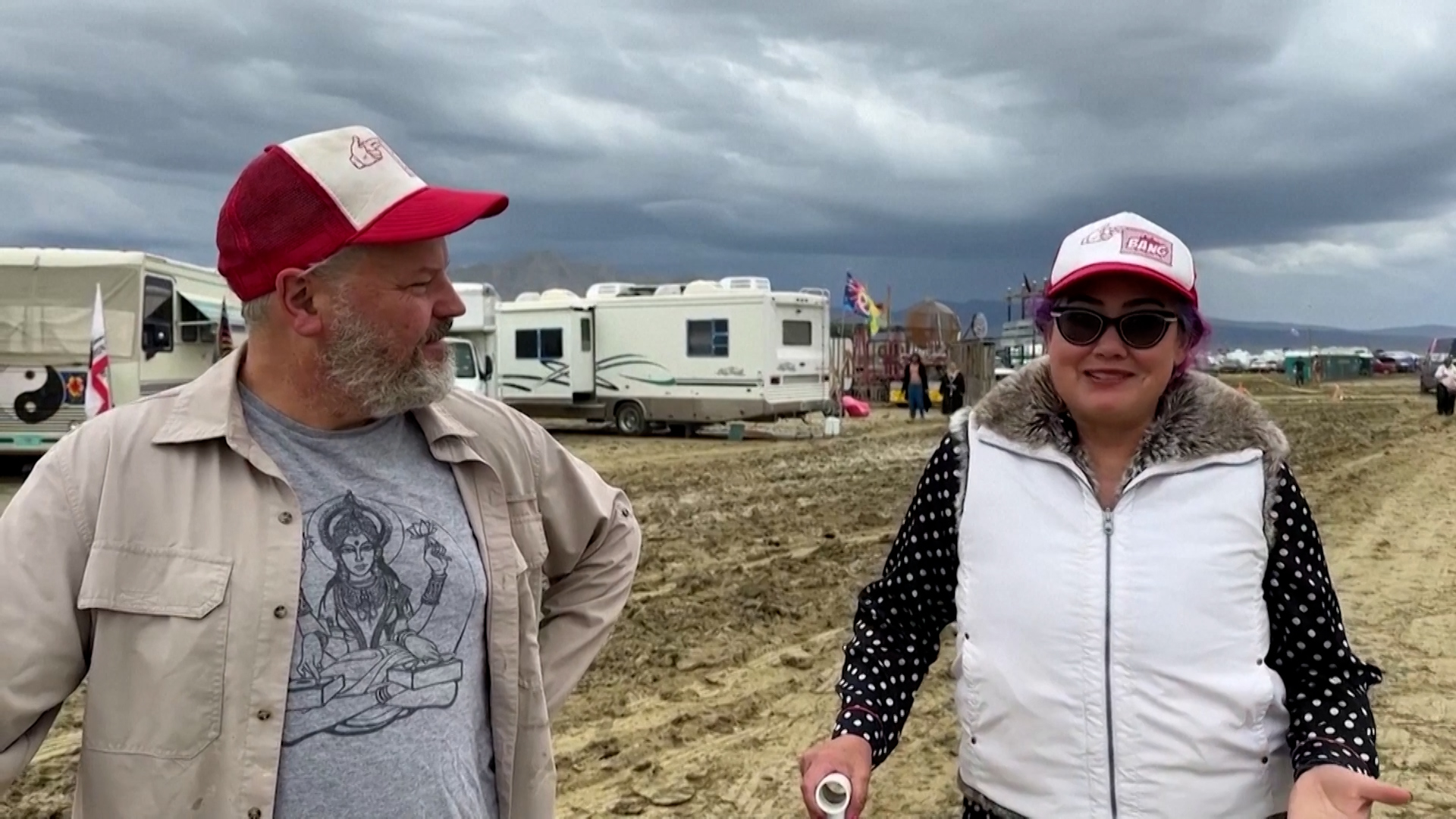
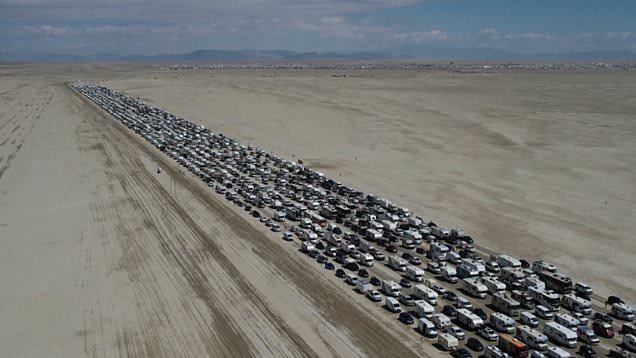
No comments:
Post a Comment